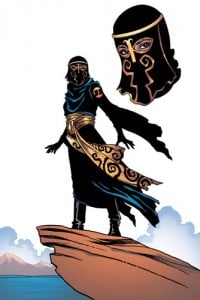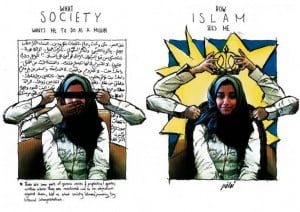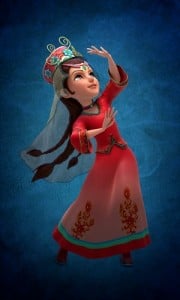A few weeks ago, Slate highlighted Iran as a topic for cartoonists. I didn’t look at all 290 cartoons (I got to 203, though!), which lampooned several years of Iran’s place in the headlines. The general consensus among cartoonists is that there are four topics which make up Iran: Ahmedinejad, nuclear issues, angry-looking mullahs, and ladies in burqas.
(sigh) How many times do I need to go over this?! Women in Iran do not wear niqabs. Show me a woman in niqab in Iran, and I will kindly point you to a map that proves you are in some other country. The last time a woman wore a face veil in Iran was in the early 1900s, before Reza Shah outlawed all veils. The most conservative dress possible in Iran is a chador. In more rural areas, closer to the Gulf, you may see Baluchi women covering their faces with traditional masks. Or you may see Afghan refugees wearing the chadaari (known to the west as a burqa). However, the vast majority of Iranian women of whatever ethnic group do not wear these types of clothing. You can see a great slide show about different styles of hejab in Iran here.
Civics lesson finished. Here are the cartoons that really busted my brain:
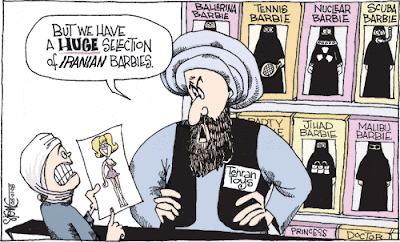 This first cartoon, drawn by Signe Wilkinson, shows a Tehrani vendor trying to sell “Iranian Barbies,” which all wear niqab. So Ms. Wilkinson hasn’t done her homework, which especially shows with her use of “Jihad Barbie” and “Nuclear Barbie,” ascribing negative, stereotypically terrorist, roles to these dolls to make them “Iranian.” Despite the fact that Iranian women do not blow themselves up for any jihad, despite the fact that the CIA released a report that Iran is not a nuclear threat.*
This first cartoon, drawn by Signe Wilkinson, shows a Tehrani vendor trying to sell “Iranian Barbies,” which all wear niqab. So Ms. Wilkinson hasn’t done her homework, which especially shows with her use of “Jihad Barbie” and “Nuclear Barbie,” ascribing negative, stereotypically terrorist, roles to these dolls to make them “Iranian.” Despite the fact that Iranian women do not blow themselves up for any jihad, despite the fact that the CIA released a report that Iran is not a nuclear threat.*
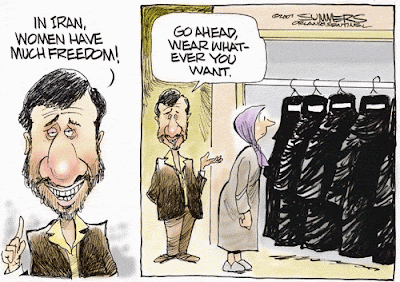 The second cartoon, drawn by Dana Summers, shows Ahmedinejad inviting an Iranian woman to wear any of her niqabs. One more time: in reality, an Iranian woman will most likely not own a niqab, let alone a closet full of them. And, in reality, what the woman in the cartoon is wearing is much more likely to be her outfit while she’s out and about. Also, the carbon-copy illustration of the niqab makes it seem like one niqab is just like another, which is ridiculously myopic. Finally, juxtaposing Ahmedinejad to this whole wardrobe decision makes it seem like he’s responsible for it (wrong again: the mandatory hejab policy was instituted by Ayatollah Khomeini).
The second cartoon, drawn by Dana Summers, shows Ahmedinejad inviting an Iranian woman to wear any of her niqabs. One more time: in reality, an Iranian woman will most likely not own a niqab, let alone a closet full of them. And, in reality, what the woman in the cartoon is wearing is much more likely to be her outfit while she’s out and about. Also, the carbon-copy illustration of the niqab makes it seem like one niqab is just like another, which is ridiculously myopic. Finally, juxtaposing Ahmedinejad to this whole wardrobe decision makes it seem like he’s responsible for it (wrong again: the mandatory hejab policy was instituted by Ayatollah Khomeini).
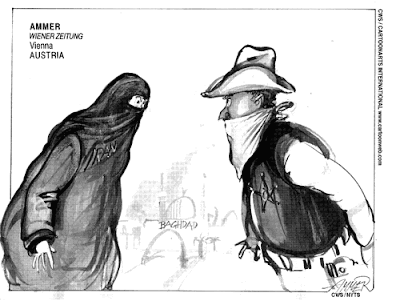 This third cartoon, drawn by Ammer for an Austrian publication, illustrates a showdown between Iran and the U.S. It’s refreshing to see Iran characterized as neither a bearded mullah or Ahmedinejad, but this illustration is incorrect still.
This third cartoon, drawn by Ammer for an Austrian publication, illustrates a showdown between Iran and the U.S. It’s refreshing to see Iran characterized as neither a bearded mullah or Ahmedinejad, but this illustration is incorrect still.
In Western public discourse, the niqab has come to represent “The Other,” and this image reinforces that connotation. The swaggering male cowboy, played by the U.S., is facing off against this mysterious, exotic, possibly-dangerous unknown female labeled “Iran” over something they both seemingly want: Baghdad. It’s a U.S. vs. Iran showdown that leaves out viewers who a) are both Iranian and American, b) are both Muslim (including those who wear niqab) and American, or c) all of the above.
The characterization of Iran as a woman (who is ostensibly unarmed) is also alarming because of the connotations of feminizing a country. A feminine (and thus lesser) country can be overpowered, exploited, and raped. While any of these can happen to men in reality, they are not often associated with white male experiences or, in this case, countries with male (and thus greater) characterization. In this cartoon, the female Muslim Iran is fixin’ to get herself into trouble by standing up to male non-Muslim America, and the cartoon thus foretells of a possible outcome of overpowering, rape, and/or murder of this Muslim woman.
These cartoons all display a great arrogance towards Muslim women, as well as a palpable misunderstanding of differences among cultures in which women cover themselves a specific way to follow religious and cultural norms.
*For a great analysis on hejab in political propaganda and Iranian women’s roles in movements in movements that could be considered a type of jihad (namely, fighting against Iraq in the ’80s), check out Fagheh Shirazi’s book The Veil Unveiled.


